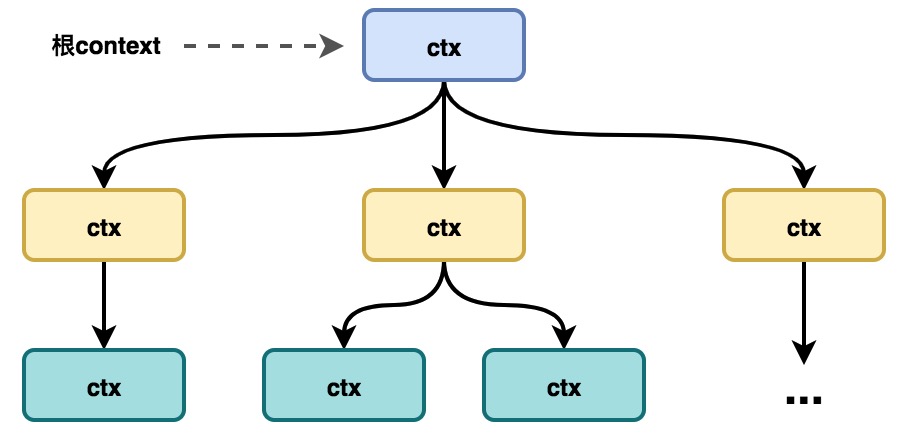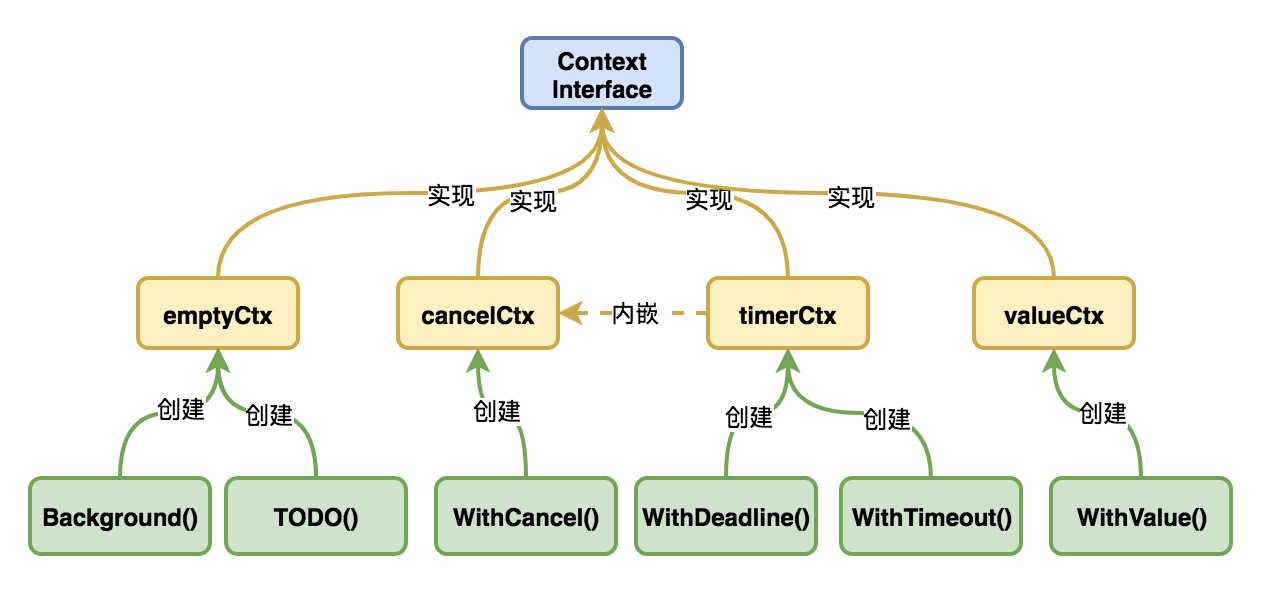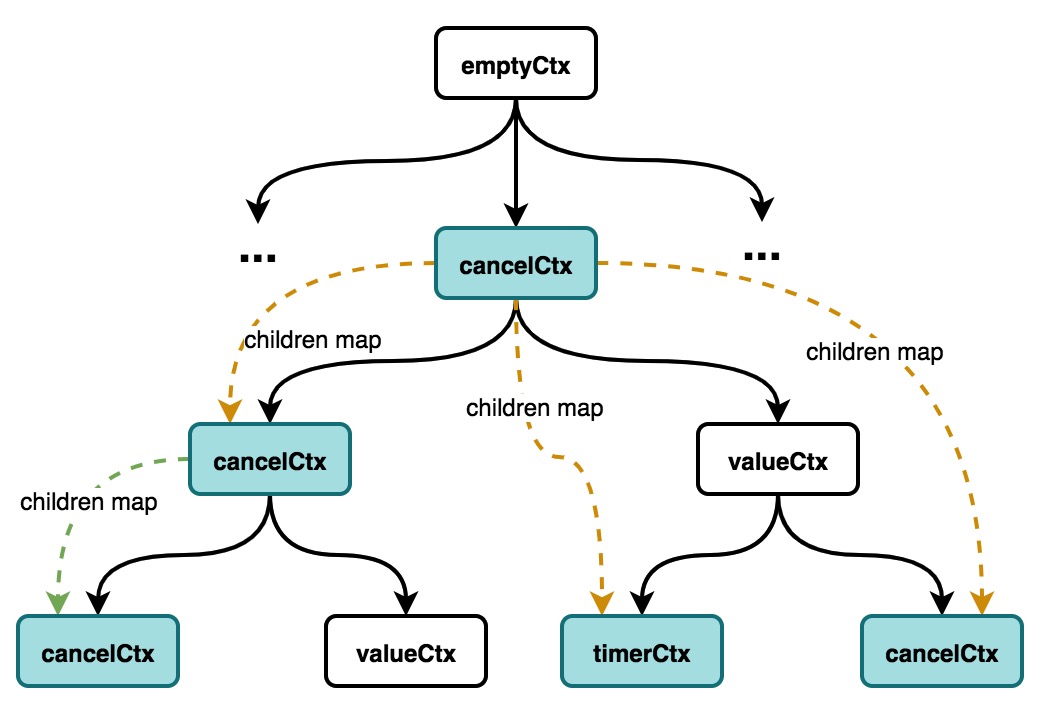Context简介
Context是由Golang官方开发的并发控制包,一方面可以用于当请求超时或者取消时候,相关的goroutine马上退出释放资源,另一方面Context本身含义就是上下文,其可以在多个goroutine或者多个处理函数之间传递共享的信息。
创建一个新的context,必须基于一个父context,新的context又可以作为其他context的父context。所有context在一起构造成一个context树。

Context使用示例
Context一大用处就是超时控制。我们先看一个简单用法。
1
2
3
4
5
6
7
8
9
10
11
12
13
14
15
16
17
18
19
20
21
22
23
24
25
26
27
28
29
| func main() {
ctx, cancel := context.WithTimeout(context.Background(), 3 * time.Second)
defer cancel()
go SlowOperation(ctx)
go func() {
for {
time.Sleep(300 * time.Millisecond)
fmt.Println("goroutine:", runtime.NumGoroutine())
}
}()
time.Sleep(4 * time.Second)
}
func SlowOperation(ctx context.Context) {
done := make(chan int, 1)
go func() {
dur := time.Duration(rand.Intn(5)+1) * time.Second
time.Sleep(dur)
done <- 1
}()
select {
case <-ctx.Done():
fmt.Println("SlowOperation timeout:", ctx.Err())
case <-done:
fmt.Println("Complete work")
}
}
|
上面代码会不停打印当前groutine数量,可以观察到SlowOperation函数执行超时之后,goroutine数量由4个变成2个,相关goroutetine退出了。源码可以去go playground查看。
再看一个关于超时处理的例子, 源码可以去go playground查看:
1
2
3
4
5
6
7
8
9
10
11
12
13
14
15
16
17
18
19
20
21
22
23
24
25
26
27
28
29
30
31
32
33
34
35
36
37
38
39
40
|
func QueryFrameworkStats(ctx context.Context, framework string) <-chan string {
stats := make(chan string)
go func() {
repos := "https://api.github.com/repos/" + framework
req, err := http.NewRequest("GET", repos, nil)
if err != nil {
return
}
req = req.WithContext(ctx)
client := &http.Client{}
resp, err := client.Do(req)
if err != nil {
return
}
data, err := ioutil.ReadAll(resp.Body)
if err != nil {
return
}
defer resp.Body.Close()
stats <- string(data)
}()
return stats
}
func main() {
ctx, cancel := context.WithTimeout(context.Background(), 3*time.Second)
defer cancel()
framework := "gin-gonic/gin"
select {
case <-ctx.Done():
fmt.Println(ctx.Err())
case statsInfo := <-QueryFrameworkStats(ctx, framework):
fmt.Println(framework, " fork and start info : ", statsInfo)
}
}
|
Context另外一个用途就是传递上下文信息。从WithValue方法我们可以创建一个可以储存键值的context
Context源码分析
Context接口
首先我们来看下Context接口
1
2
3
4
5
6
| type Context interface {
Deadline() (deadline time.Time, ok bool)
Done() <-chan struct{}
Err() error
Value(key interface{}) interface{}
}
|
Context接口一共包含四个方法:
- Deadline:返回绑定该context任务的执行超时时间,若未设置,则ok等于false
- Done:返回一个只读通道,当绑定该context的任务执行完成并调用cancel方法或者任务执行超时时候,该通道会被关闭
- Err:返回一个错误,如果Done返回的通道未关闭则返回nil,如果context如果被取消,返回
Canceled错误,如果超时则会返回DeadlineExceeded错误
- Value:根据key返回,存储在context中k-v数据
实现Context接口的类型
Context一共有4个类型实现了Context接口, 分别是emptyCtx, cancelCtx,timerCtx,valueCtx。每个类型都关联一个创建方法。

emptyCtx
emptyCtx是int类型,emptyCtx实现了Context接口,是一个空context,只能作为根context。
1
2
3
4
5
6
7
8
9
10
11
12
13
14
15
16
17
18
19
20
21
22
23
24
25
26
27
| type emptyCtx int
func (*emptyCtx) Deadline() (deadline time.Time, ok bool) {
return
}
func (*emptyCtx) Done() <-chan struct{} {
return nil
}
func (*emptyCtx) Err() error {
return nil
}
func (*emptyCtx) Value(key interface{}) interface{} {
return nil
}
func (e *emptyCtx) String() string {
switch e {
case background:
return "context.Background"
case todo:
return "context.TODO"
}
return "unknown empty Context"
}
|
Background/TODO
context包还提供两个函数返回emptyCtx类型。
1
2
3
4
5
6
7
8
9
10
11
12
| var (
background = new(emptyCtx)
todo = new(emptyCtx)
)
func Background() Context {
return background
}
func TODO() Context {
return todo
}
|
Background用于创建根context,一般用于主函数、初始化和测试中,我们创建的context一般都是基于Bacground创建的。TODO用于当我们不确定使用什么样的context的时候使用。
cancelCtx
cancelCtx支持取消操作,取消同时也会对实现了canceler接口的子代进行取消操作。我们来看下cancelCtx结构体和cancelceler接口:
1
2
3
4
5
6
7
8
9
10
11
12
| type cancelCtx struct {
Context
mu sync.Mutex
done chan struct{}
children map[canceler]struct{}
err error
}
type canceler interface {
cancel(removeFromParent bool, err error)
Done() <-chan struct{}
}
|
cancelCtx:
Context变量存储其父contextdone变量定义了一个通道,并且只在第一次取消调用才关闭此通道。该通道是惰性创建的children是一个映射类型,用来存储其子代context中实现的canceler,当该context取消时候,会遍历该映射来让子代context进行取消操作err记录错误信息,默认是nil,仅当第一次cancel调用时候,才会设置。
我们分别来看下cancelCtx实现的Done,Err,cancel方法。
1
2
3
4
5
6
7
8
9
10
11
12
13
14
15
16
17
18
19
20
21
22
23
24
25
26
27
28
29
30
31
32
33
34
35
36
37
38
39
40
41
42
43
44
45
46
47
48
49
50
51
52
53
54
55
56
57
58
59
60
61
62
63
64
65
66
67
68
69
70
71
72
73
74
75
76
77
78
| func (c *cancelCtx) Done() <-chan struct{} {
c.mu.Lock()
if c.done == nil {
c.done = make(chan struct{})
}
d := c.done
c.mu.Unlock()
return d
}
func (c *cancelCtx) Err() error {
c.mu.Lock()
err := c.err
c.mu.Unlock()
return err
}
func (c *cancelCtx) cancel(removeFromParent bool, err error) {
if err == nil {
panic("context: internal error: missing cancel error")
}
c.mu.Lock()
if c.err != nil {
c.mu.Unlock()
return
}
c.err = err
if c.done == nil {
c.done = closedchan
} else {
close(c.done)
}
for child := range c.children {
child.cancel(false, err)
}
c.children = nil
c.mu.Unlock()
if removeFromParent {
removeChild(c.Context, c)
}
}
func removeChild(parent Context, child canceler) {
p, ok := parentCancelCtx(parent)
if !ok {
return
}
p.mu.Lock()
if p.children != nil {
delete(p.children, child)
}
p.mu.Unlock()
}
func parentCancelCtx(parent Context) (*cancelCtx, bool) {
for {
switch c := parent.(type) {
case *cancelCtx:
return c, true
case *timerCtx:
return &c.cancelCtx, true
case *valueCtx:
parent = c.Context
default:
return nil, false
}
}
}
|
注意parentCancelCtx找到的节点不一定是就是父context,有可能是其父辈的context。可以参考下面这种图:

WithCancel
接下来看cancelCtx类型Context的创建。WithCancel会创一个cancelCtx,以及它关联的取消函数。
1
2
3
4
5
6
7
8
9
10
11
12
13
14
15
16
17
18
19
20
21
22
23
24
25
26
27
28
29
30
31
32
33
34
35
36
37
38
39
40
41
42
43
44
45
46
| type CancelFunc func()
func WithCancel(parent Context) (ctx Context, cancel CancelFunc) {
c := newCancelCtx(parent)
propagateCancel(parent, &c)
return &c, func() { c.cancel(true, Canceled) }
}
func newCancelCtx(parent Context) cancelCtx {
return cancelCtx{Context: parent}
}
func propagateCancel(parent Context, child canceler) {
if parent.Done() == nil {
return
}
if p, ok := parentCancelCtx(parent); ok {
p.mu.Lock()
if p.err != nil {
child.cancel(false, p.err)
} else {
if p.children == nil {
p.children = make(map[canceler]struct{})
}
p.children[child] = struct{}{}
}
p.mu.Unlock()
} else {
go func() {
select {
case <-parent.Done():
child.cancel(false, parent.Err())
case <-child.Done():
}
}()
}
}
|
timerCtx
timerCtx是基于cancelCtx的context类型,它支持过期取消。
1
2
3
4
5
6
7
8
9
10
11
12
13
14
15
16
17
18
19
20
21
22
23
24
25
26
27
28
29
30
| type timerCtx struct {
cancelCtx
timer *time.Timer
deadline time.Time
}
func (c *timerCtx) Deadline() (deadline time.Time, ok bool) {
return c.deadline, true
}
func (c *timerCtx) String() string {
return contextName(c.cancelCtx.Context) + ".WithDeadline(" +
c.deadline.String() + " [" +
time.Until(c.deadline).String() + "])"
}
func (c *timerCtx) cancel(removeFromParent bool, err error) {
c.cancelCtx.cancel(false, err)
if removeFromParent {
removeChild(c.cancelCtx.Context, c)
}
c.mu.Lock()
if c.timer != nil {
c.timer.Stop()
c.timer = nil
}
c.mu.Unlock()
}
|
WithDeadline
WithDeadline会创建一个timerCtx,以及它关联的取消函数
1
2
3
4
5
6
7
8
9
10
11
12
13
14
15
16
17
18
19
20
21
22
23
24
25
26
| func WithDeadline(parent Context, d time.Time) (Context, CancelFunc) {
if cur, ok := parent.Deadline(); ok && cur.Before(d) {
return WithCancel(parent)
}
c := &timerCtx{
cancelCtx: newCancelCtx(parent),
deadline: d,
}
propagateCancel(parent, c)
dur := time.Until(d)
if dur <= 0 {
c.cancel(true, DeadlineExceeded)
return c, func() { c.cancel(false, Canceled) }
}
c.mu.Lock()
defer c.mu.Unlock()
if c.err == nil {
c.timer = time.AfterFunc(dur, func() {
c.cancel(true, DeadlineExceeded)
})
}
return c, func() { c.cancel(true, Canceled) }
}
|
WithTimeout
WithTimeout用来创建超时就会取消的context,内部实现就是WithDealine,传递给WithDealine的过期时间就是当前时间加上timeout时间
1
2
3
| func WithTimeout(parent Context, timeout time.Duration) (Context, CancelFunc) {
return WithDeadline(parent, time.Now().Add(timeout))
}
|
valueCtx
valueCtx是可以传递共享信息的context。
1
2
3
4
5
6
7
8
9
10
11
12
13
14
| type valueCtx struct {
Context
key, val interface{}
}
func (c *valueCtx) Value(key interface{}) interface{} {
if c.key == key {
return c.val
}
return c.Context.Value(key)
}
|
如果当前context不存在该key,则会沿着context树,向上递归查找,直到查找到根context,最后返回nil

WithValue
WithValue用来创建valueCtx。如果key是不可以比较的时候,则会发生恐慌。可以比较类型,可以参考Comparison_operators。key应该是不导出变量,防止冲突。
1
2
3
4
5
6
7
8
9
| func WithValue(parent Context, key, val interface{}) Context {
if key == nil {
panic("nil key")
}
if !reflectlite.TypeOf(key).Comparable() {
panic("key is not comparable")
}
return &valueCtx{parent, key, val}
}
|
总结
实现Context接口的类型
Context一共有4个类型实现了Context接口, 分别是emptyCtx, cancelCtx,timerCtx,valueCtx。
它们的功能与创建方法如下:
| 类型 |
创建方法 |
功能 |
| emptyCtx |
Background()/TODO() |
用做context树的根节点 |
| cancelCtx |
WithCancel() |
可取消的context |
| timerCtx |
WithDeadline()/WithTimeout() |
可取消的context,过期或超时会自动取消 |
| valueCtx |
WithValue() |
可存储共享信息的context |
Context实现两种递归
Context实现两种方向的递归操作。
| 递归方向 |
目的 |
| 向下递归 |
当对父Context进去手动取消操作,或超时取消时候,向下递归处理对实现了canceler接口的后代进行取消操作 |
| 向上队规 |
当对Context查询Key信息时候,若当前Context没有当前K-V信息时候,则向父辈递归查询,一直到查询到跟节点的emptyCtx,返回nil为止 |
Context使用规范
使用Context的是应该准守以下原则来保证在不同包中使用时候的接口一致性,以及能让静态分析工具可以检查context的传播:
- 不要将Context作为结构体的一个字段存储,相反而应该显示传递Context给每一个需要它的函数,Context应该作为函数的第一个参数,并命名为ctx
- 不要传递一个nil Context给一个函数,即使该函数能够接受它。如果你不确定使用哪一个Context,那你就传递context.TODO
- context是并发安全的,相同的Context能够传递给运行在不同goroutine的函数
参考资料



